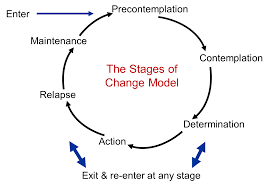Prochaska and DiClemente's Transtheoretical Model of Change

These two researchers tried to understand how and why people change, whether they do it on their own or with a therapist’s help. They’ve also outlined stages that every person who wants to drop a habit (using drugs, eating processed foods, etc) will go through. Their model also works for most of the New Year’s resolutions you might set.
These stages apply with any kind of change you try to make on your own, but they also apply if you get help from a therapist. With or without therapy, everyone seems to go through similar phases, and processes things in an equally similar way.
In this model, we can look at motivation as a person’s current state, or what stage of preparation for change they’re in. This is really important because a lot of the time we use the word “motivation” incorrectly. On top of that, motivation is absolutely necessary for any process of personal change.
“Men’s courses will foreshadow certain ends, to which, if persevered in, they must lead,” said Scrooge. “But if the courses be departed from, the ends will change. Say it is thus with what you show me!”
-Ebenezer Scrooge to the Ghost of Christmas Yet to Come, in A Christmas Carol, by Charles Dickens-
The wheel of change in the transtheoretical model of change
The “wheel of change” in Prochaska and DiClemente’s transtheoretical model of change says there are four, five, or six stages of change and that they’re shaped like a wheel. That is, they form a circle. So people who want to drop an addictive behavior will go through the different stages on the wheel almost like they’re sliding along it.
There’s a reason they call it a wheel: in any process of change, people spin through the process multiple times before they get to a stable kind of change. In their early research with smokers, for example, Prochaska and DiClemente found that smokers went through the wheel between three and seven times (on average, four) before they stopped smoking like they wanted to.
In this wheel, relapse is totally normal. The two researchers see it as just another stage of change. As psychologists, sometimes we tell our patients that “every relapse just gets you one step closer to recovery.”
Of course that doesn’t mean that we’re encouraging them to relapse, not at all. We’re just trying to remind them not to get discouraged and fall to pieces when they have a relapse.

The precontemplation stage
The entry point for the process of change is the “precontemplation” stage. This means someone still doesn’t think they have a problem or need to make any kind of change in their life. A “precontemplator” is someone who knows they have a problem, even if they aren’t conscious of it.
The contemplation stage
Once they become conscious of the problem, they’ll go into a period that’s mostly about ambivalence, the “contemplation” stage. Someone in this stage will simultaneously think about and reject the idea of change. The best way to describe their experience is a back-and-forth between reasons to change and reasons to keep on living the same way.
Someone who has a drinking problem and finds themselves in this stage, for example, might say something like this:
“I don’t think I have a drinking problem. Maybe I drink a little bit too much, but I don’t think I drink any more than any of my friends. I can stop drinking whenever I feel like it.”
As you can see, they may recognize they have a problem but they feel like they’re in control.

The preparation stage
In the transtheoretical model of change, the preparation stage is like a window of opportunity. It makes way for a new phase of life. If someone in this stage manages to enter the action stage, their process of change will move forward. If they don’t, they’ll go back to the contemplation stage.
The action stage
The “action” stage is what most people see as the stage where therapy starts. This is where people start to take certain actions that will help them change.
For example, most people who stop smoking do it on their own. The goal during this stage is to create a change in the problem you want to solve. But just having the intention to change doesn’t guarantee that you’ll maintain that change over time.
The maintenance stage
In this stage the challenge is to maintain the change you achieved in the last stage, and to not relapse. Quitting drugs, drinking less, and losing weight are all early stages of change. What comes next is maintaining this change.

Relapse
Lastly, if you have a relapse, your next job will be to get right back on the wheel before you get stuck in this stage. Falls and relapses are totally normal. You should expect them when you try to change any behavioral pattern you’ve had for a long time.
To conclude, the transtheoretical model of change has a few stages that always move in a circle. Someone who wants to change an addictive behavior will go through these stages in their own way until they finally manage to maintain their change.
Bibliography
William R. Miller and Stephen Rollnick. Motivational Interviewing: Preparing People to Change Addictive Behaviorl. Guilford Press. New York, 1991.
These two researchers tried to understand how and why people change, whether they do it on their own or with a therapist’s help. They’ve also outlined stages that every person who wants to drop a habit (using drugs, eating processed foods, etc) will go through. Their model also works for most of the New Year’s resolutions you might set.
These stages apply with any kind of change you try to make on your own, but they also apply if you get help from a therapist. With or without therapy, everyone seems to go through similar phases, and processes things in an equally similar way.
In this model, we can look at motivation as a person’s current state, or what stage of preparation for change they’re in. This is really important because a lot of the time we use the word “motivation” incorrectly. On top of that, motivation is absolutely necessary for any process of personal change.
“Men’s courses will foreshadow certain ends, to which, if persevered in, they must lead,” said Scrooge. “But if the courses be departed from, the ends will change. Say it is thus with what you show me!”
-Ebenezer Scrooge to the Ghost of Christmas Yet to Come, in A Christmas Carol, by Charles Dickens-
The wheel of change in the transtheoretical model of change
The “wheel of change” in Prochaska and DiClemente’s transtheoretical model of change says there are four, five, or six stages of change and that they’re shaped like a wheel. That is, they form a circle. So people who want to drop an addictive behavior will go through the different stages on the wheel almost like they’re sliding along it.
There’s a reason they call it a wheel: in any process of change, people spin through the process multiple times before they get to a stable kind of change. In their early research with smokers, for example, Prochaska and DiClemente found that smokers went through the wheel between three and seven times (on average, four) before they stopped smoking like they wanted to.
In this wheel, relapse is totally normal. The two researchers see it as just another stage of change. As psychologists, sometimes we tell our patients that “every relapse just gets you one step closer to recovery.”
Of course that doesn’t mean that we’re encouraging them to relapse, not at all. We’re just trying to remind them not to get discouraged and fall to pieces when they have a relapse.

The precontemplation stage
The entry point for the process of change is the “precontemplation” stage. This means someone still doesn’t think they have a problem or need to make any kind of change in their life. A “precontemplator” is someone who knows they have a problem, even if they aren’t conscious of it.
The contemplation stage
Once they become conscious of the problem, they’ll go into a period that’s mostly about ambivalence, the “contemplation” stage. Someone in this stage will simultaneously think about and reject the idea of change. The best way to describe their experience is a back-and-forth between reasons to change and reasons to keep on living the same way.
Someone who has a drinking problem and finds themselves in this stage, for example, might say something like this:
“I don’t think I have a drinking problem. Maybe I drink a little bit too much, but I don’t think I drink any more than any of my friends. I can stop drinking whenever I feel like it.”
As you can see, they may recognize they have a problem but they feel like they’re in control.

The preparation stage
In the transtheoretical model of change, the preparation stage is like a window of opportunity. It makes way for a new phase of life. If someone in this stage manages to enter the action stage, their process of change will move forward. If they don’t, they’ll go back to the contemplation stage.
The action stage
The “action” stage is what most people see as the stage where therapy starts. This is where people start to take certain actions that will help them change.
For example, most people who stop smoking do it on their own. The goal during this stage is to create a change in the problem you want to solve. But just having the intention to change doesn’t guarantee that you’ll maintain that change over time.
The maintenance stage
In this stage the challenge is to maintain the change you achieved in the last stage, and to not relapse. Quitting drugs, drinking less, and losing weight are all early stages of change. What comes next is maintaining this change.

Relapse
Lastly, if you have a relapse, your next job will be to get right back on the wheel before you get stuck in this stage. Falls and relapses are totally normal. You should expect them when you try to change any behavioral pattern you’ve had for a long time.
To conclude, the transtheoretical model of change has a few stages that always move in a circle. Someone who wants to change an addictive behavior will go through these stages in their own way until they finally manage to maintain their change.
Bibliography
William R. Miller and Stephen Rollnick. Motivational Interviewing: Preparing People to Change Addictive Behaviorl. Guilford Press. New York, 1991.
All cited sources were thoroughly reviewed by our team to ensure their quality, reliability, currency, and validity. The bibliography of this article was considered reliable and of academic or scientific accuracy.
- William R. Miller y Stephen Rollnick. La entrevista motivacional. Ed. Paidós. Barcelona, 1999.
- Prochaska, JO, y DiClemente, CC (1983). Etapas y procesos de auto cambio de fumar: Hacia un modelo integrador de cambio. Revista de consultoría y psicología clínica , 51 (3), 390-395. https://doi.org/10.1037/0022-006X.51.3.390
- Prochaska, JO, y Diclemente, CC (1986). Hacia un modelo integral de cambio. En el tratamiento de conductas adictivas (págs. 3–27). Boston, MA: Springer US. https://doi.org/10.1007/978-1-4613-2191-0_1
This text is provided for informational purposes only and does not replace consultation with a professional. If in doubt, consult your specialist.







